A Report on Fly Pelican Airlines: Business Model Canvas Analysis
VerifiedAdded on 2023/06/08
|14
|2573
|374
Report
AI Summary
This report provides a comprehensive business model canvas analysis of Fly Pelican, a regional airline in Australia. It begins with an introduction to the airline, highlighting its operations and key destinations. The report then delves into the business model, focusing on the nine building blocks: customer segments, key partners, value proposition, key activities, channels, revenue streams, cost structure, key resources, and customer relationships. It identifies critical success factors for the airline, such as low-cost operations and a point-to-point model, and discusses potential downside risks and business model changes for future growth. The analysis emphasizes the importance of strategic partnerships, efficient resource utilization, and customer satisfaction for Fly Pelican's sustainability and profitability. Desklib provides this report and many other solved assignments for students.
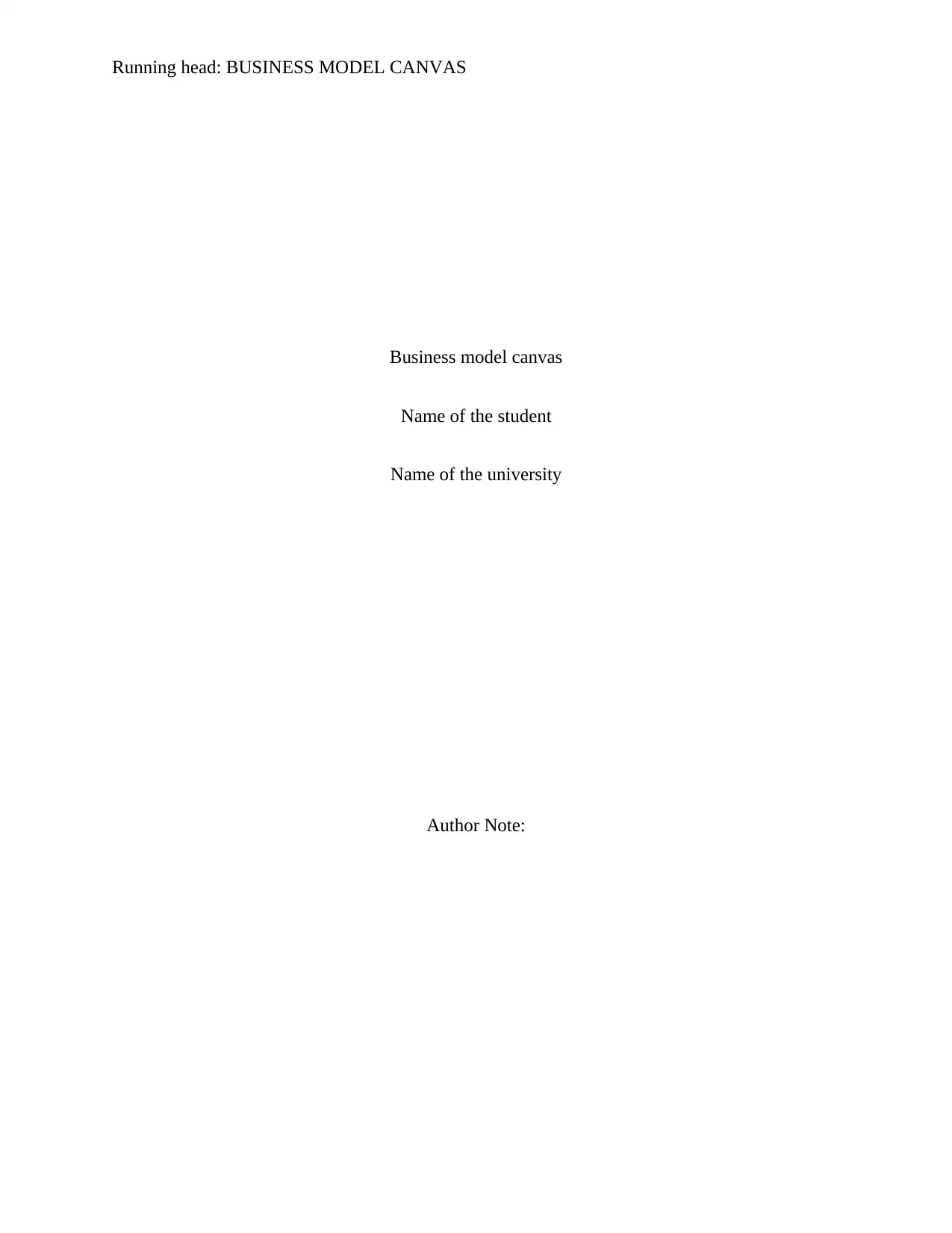
Running head: BUSINESS MODEL CANVAS
Business model canvas
Name of the student
Name of the university
Author Note:
Business model canvas
Name of the student
Name of the university
Author Note:
Paraphrase This Document
Need a fresh take? Get an instant paraphrase of this document with our AI Paraphraser
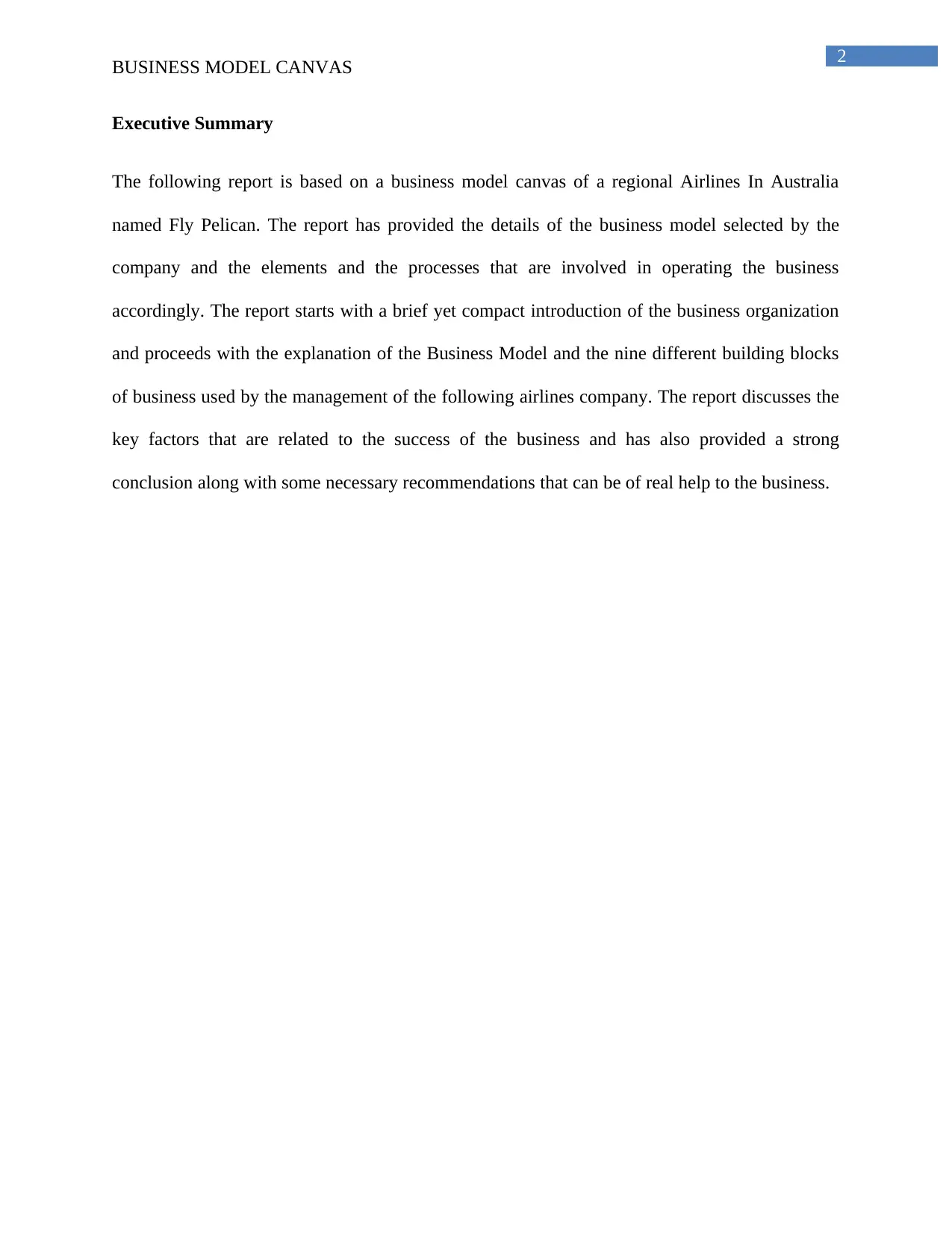
2
BUSINESS MODEL CANVAS
Executive Summary
The following report is based on a business model canvas of a regional Airlines In Australia
named Fly Pelican. The report has provided the details of the business model selected by the
company and the elements and the processes that are involved in operating the business
accordingly. The report starts with a brief yet compact introduction of the business organization
and proceeds with the explanation of the Business Model and the nine different building blocks
of business used by the management of the following airlines company. The report discusses the
key factors that are related to the success of the business and has also provided a strong
conclusion along with some necessary recommendations that can be of real help to the business.
BUSINESS MODEL CANVAS
Executive Summary
The following report is based on a business model canvas of a regional Airlines In Australia
named Fly Pelican. The report has provided the details of the business model selected by the
company and the elements and the processes that are involved in operating the business
accordingly. The report starts with a brief yet compact introduction of the business organization
and proceeds with the explanation of the Business Model and the nine different building blocks
of business used by the management of the following airlines company. The report discusses the
key factors that are related to the success of the business and has also provided a strong
conclusion along with some necessary recommendations that can be of real help to the business.
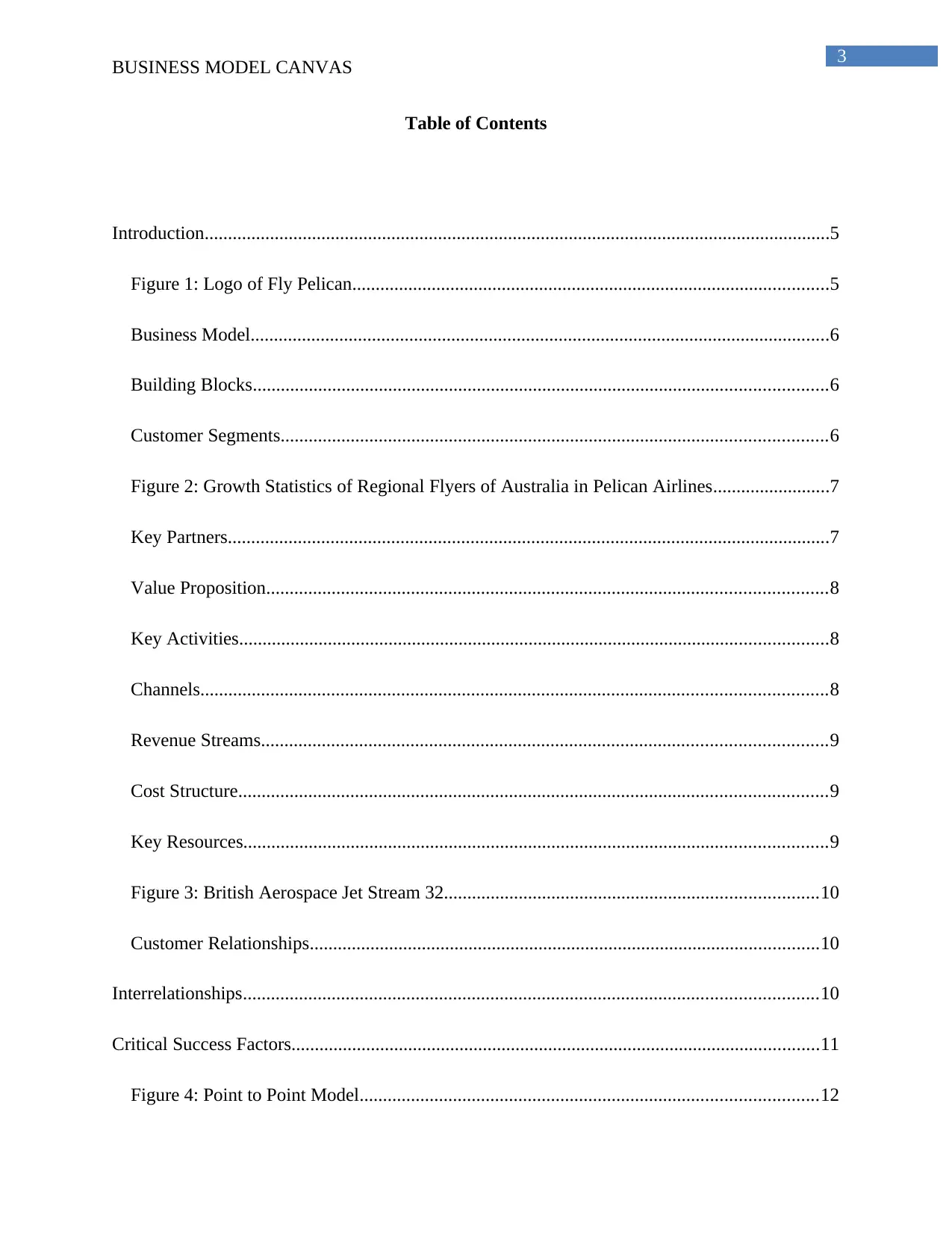
3
BUSINESS MODEL CANVAS
Table of Contents
Introduction......................................................................................................................................5
Figure 1: Logo of Fly Pelican......................................................................................................5
Business Model............................................................................................................................6
Building Blocks...........................................................................................................................6
Customer Segments.....................................................................................................................6
Figure 2: Growth Statistics of Regional Flyers of Australia in Pelican Airlines.........................7
Key Partners.................................................................................................................................7
Value Proposition........................................................................................................................8
Key Activities..............................................................................................................................8
Channels......................................................................................................................................8
Revenue Streams.........................................................................................................................9
Cost Structure..............................................................................................................................9
Key Resources.............................................................................................................................9
Figure 3: British Aerospace Jet Stream 32................................................................................10
Customer Relationships.............................................................................................................10
Interrelationships...........................................................................................................................10
Critical Success Factors.................................................................................................................11
Figure 4: Point to Point Model..................................................................................................12
BUSINESS MODEL CANVAS
Table of Contents
Introduction......................................................................................................................................5
Figure 1: Logo of Fly Pelican......................................................................................................5
Business Model............................................................................................................................6
Building Blocks...........................................................................................................................6
Customer Segments.....................................................................................................................6
Figure 2: Growth Statistics of Regional Flyers of Australia in Pelican Airlines.........................7
Key Partners.................................................................................................................................7
Value Proposition........................................................................................................................8
Key Activities..............................................................................................................................8
Channels......................................................................................................................................8
Revenue Streams.........................................................................................................................9
Cost Structure..............................................................................................................................9
Key Resources.............................................................................................................................9
Figure 3: British Aerospace Jet Stream 32................................................................................10
Customer Relationships.............................................................................................................10
Interrelationships...........................................................................................................................10
Critical Success Factors.................................................................................................................11
Figure 4: Point to Point Model..................................................................................................12
You're viewing a preview
Unlock full access by subscribing today!
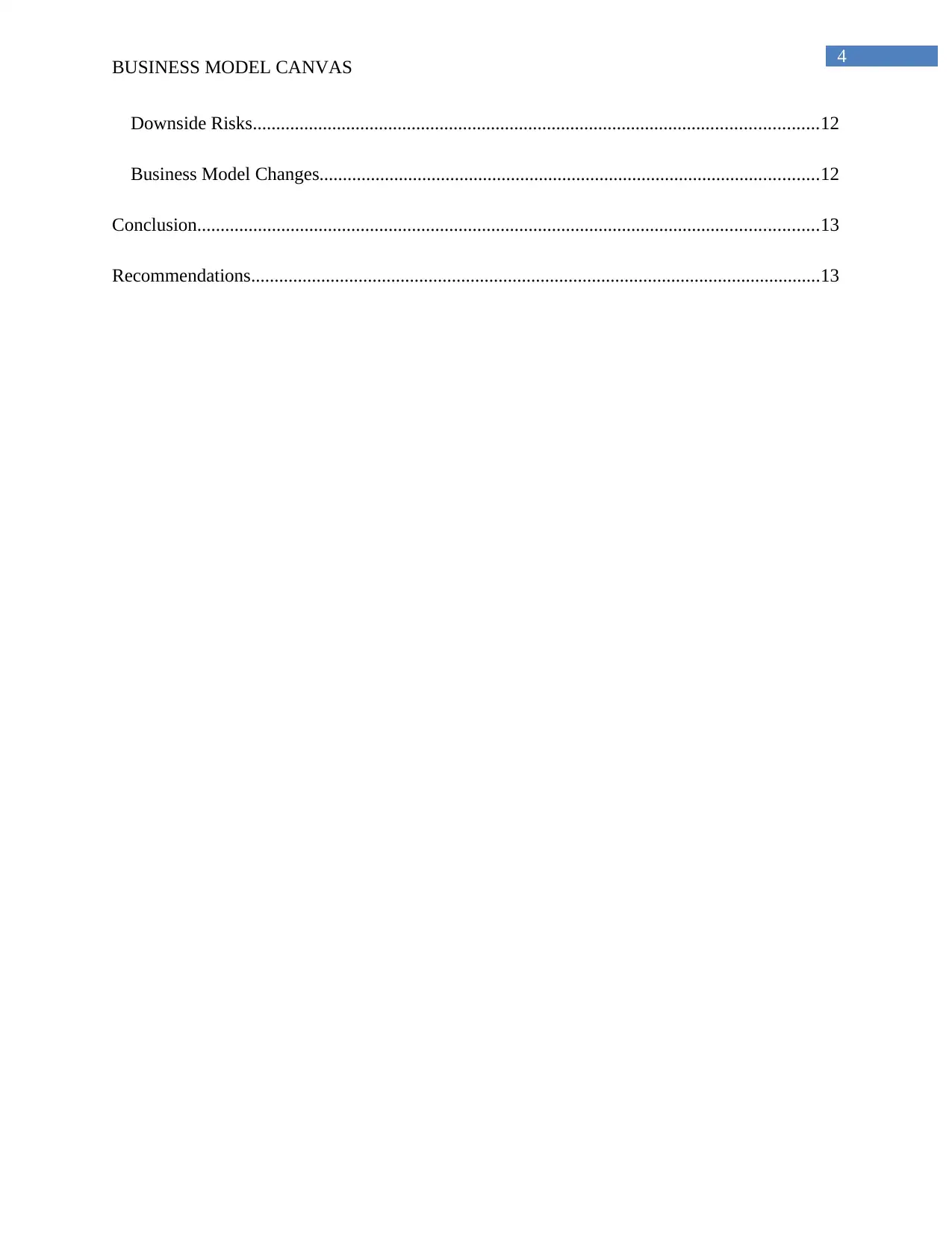
4
BUSINESS MODEL CANVAS
Downside Risks.........................................................................................................................12
Business Model Changes...........................................................................................................12
Conclusion.....................................................................................................................................13
Recommendations..........................................................................................................................13
BUSINESS MODEL CANVAS
Downside Risks.........................................................................................................................12
Business Model Changes...........................................................................................................12
Conclusion.....................................................................................................................................13
Recommendations..........................................................................................................................13
Paraphrase This Document
Need a fresh take? Get an instant paraphrase of this document with our AI Paraphraser
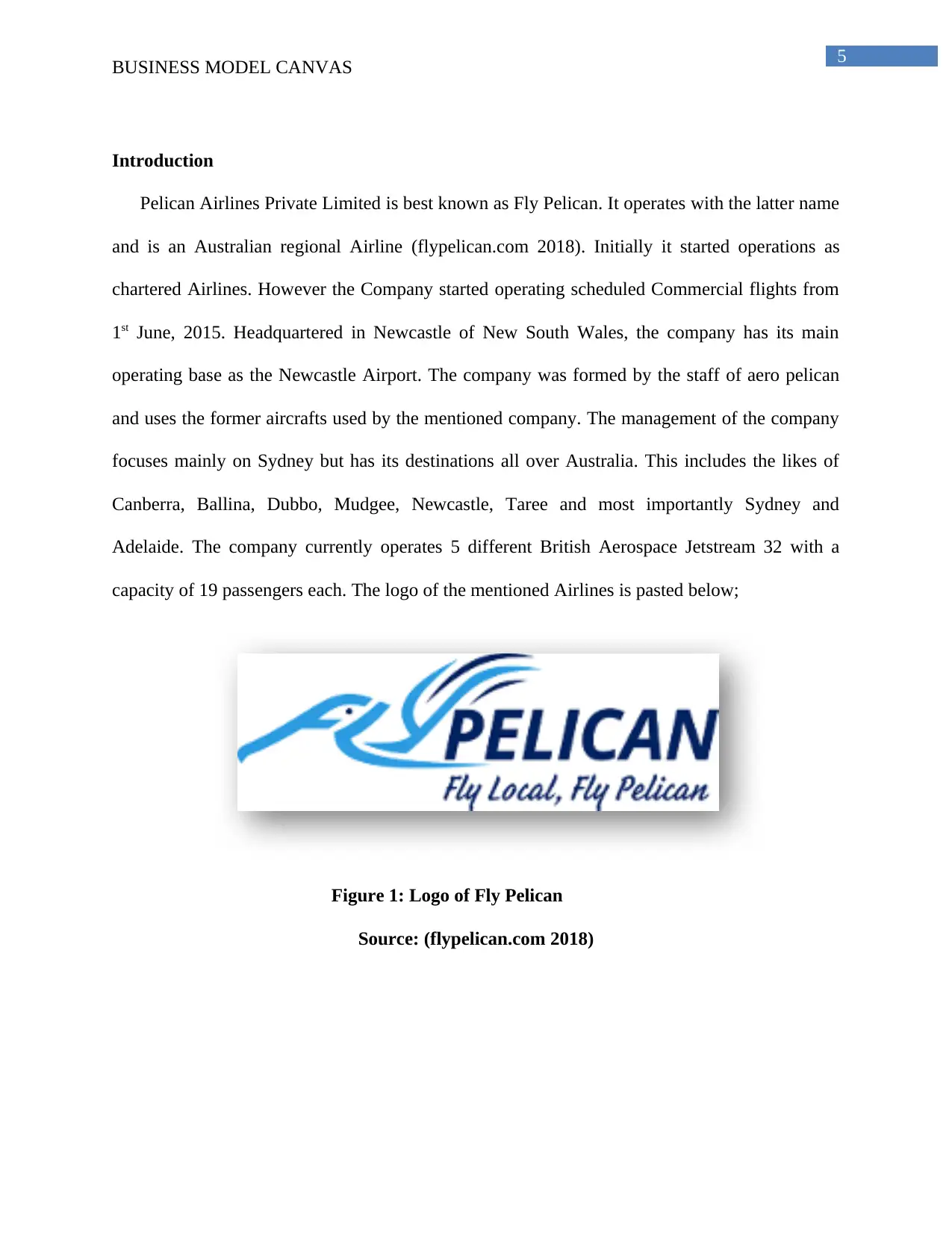
5
BUSINESS MODEL CANVAS
Introduction
Pelican Airlines Private Limited is best known as Fly Pelican. It operates with the latter name
and is an Australian regional Airline (flypelican.com 2018). Initially it started operations as
chartered Airlines. However the Company started operating scheduled Commercial flights from
1st June, 2015. Headquartered in Newcastle of New South Wales, the company has its main
operating base as the Newcastle Airport. The company was formed by the staff of aero pelican
and uses the former aircrafts used by the mentioned company. The management of the company
focuses mainly on Sydney but has its destinations all over Australia. This includes the likes of
Canberra, Ballina, Dubbo, Mudgee, Newcastle, Taree and most importantly Sydney and
Adelaide. The company currently operates 5 different British Aerospace Jetstream 32 with a
capacity of 19 passengers each. The logo of the mentioned Airlines is pasted below;
Figure 1: Logo of Fly Pelican
Source: (flypelican.com 2018)
BUSINESS MODEL CANVAS
Introduction
Pelican Airlines Private Limited is best known as Fly Pelican. It operates with the latter name
and is an Australian regional Airline (flypelican.com 2018). Initially it started operations as
chartered Airlines. However the Company started operating scheduled Commercial flights from
1st June, 2015. Headquartered in Newcastle of New South Wales, the company has its main
operating base as the Newcastle Airport. The company was formed by the staff of aero pelican
and uses the former aircrafts used by the mentioned company. The management of the company
focuses mainly on Sydney but has its destinations all over Australia. This includes the likes of
Canberra, Ballina, Dubbo, Mudgee, Newcastle, Taree and most importantly Sydney and
Adelaide. The company currently operates 5 different British Aerospace Jetstream 32 with a
capacity of 19 passengers each. The logo of the mentioned Airlines is pasted below;
Figure 1: Logo of Fly Pelican
Source: (flypelican.com 2018)
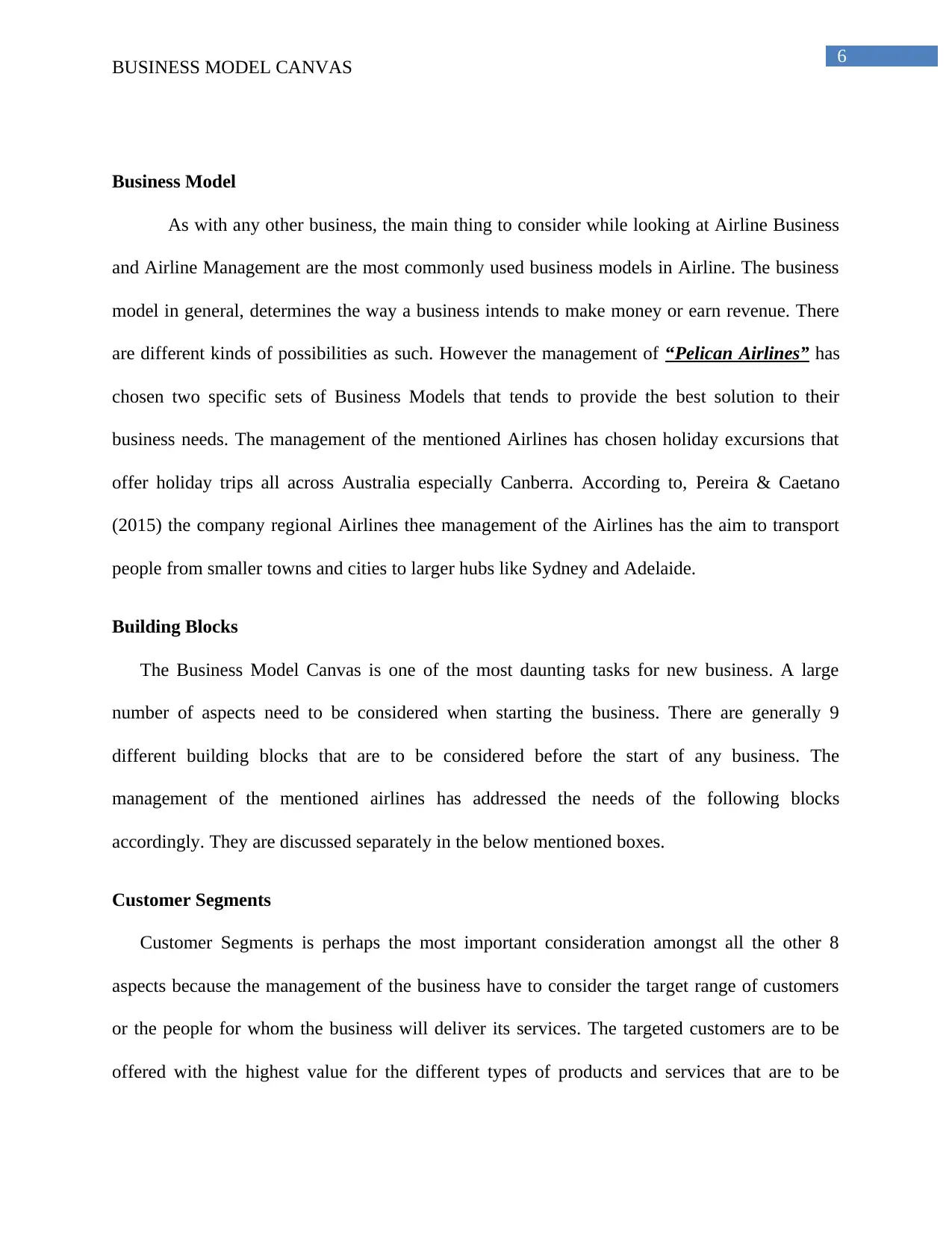
6
BUSINESS MODEL CANVAS
Business Model
As with any other business, the main thing to consider while looking at Airline Business
and Airline Management are the most commonly used business models in Airline. The business
model in general, determines the way a business intends to make money or earn revenue. There
are different kinds of possibilities as such. However the management of “Pelican Airlines” has
chosen two specific sets of Business Models that tends to provide the best solution to their
business needs. The management of the mentioned Airlines has chosen holiday excursions that
offer holiday trips all across Australia especially Canberra. According to, Pereira & Caetano
(2015) the company regional Airlines thee management of the Airlines has the aim to transport
people from smaller towns and cities to larger hubs like Sydney and Adelaide.
Building Blocks
The Business Model Canvas is one of the most daunting tasks for new business. A large
number of aspects need to be considered when starting the business. There are generally 9
different building blocks that are to be considered before the start of any business. The
management of the mentioned airlines has addressed the needs of the following blocks
accordingly. They are discussed separately in the below mentioned boxes.
Customer Segments
Customer Segments is perhaps the most important consideration amongst all the other 8
aspects because the management of the business have to consider the target range of customers
or the people for whom the business will deliver its services. The targeted customers are to be
offered with the highest value for the different types of products and services that are to be
BUSINESS MODEL CANVAS
Business Model
As with any other business, the main thing to consider while looking at Airline Business
and Airline Management are the most commonly used business models in Airline. The business
model in general, determines the way a business intends to make money or earn revenue. There
are different kinds of possibilities as such. However the management of “Pelican Airlines” has
chosen two specific sets of Business Models that tends to provide the best solution to their
business needs. The management of the mentioned Airlines has chosen holiday excursions that
offer holiday trips all across Australia especially Canberra. According to, Pereira & Caetano
(2015) the company regional Airlines thee management of the Airlines has the aim to transport
people from smaller towns and cities to larger hubs like Sydney and Adelaide.
Building Blocks
The Business Model Canvas is one of the most daunting tasks for new business. A large
number of aspects need to be considered when starting the business. There are generally 9
different building blocks that are to be considered before the start of any business. The
management of the mentioned airlines has addressed the needs of the following blocks
accordingly. They are discussed separately in the below mentioned boxes.
Customer Segments
Customer Segments is perhaps the most important consideration amongst all the other 8
aspects because the management of the business have to consider the target range of customers
or the people for whom the business will deliver its services. The targeted customers are to be
offered with the highest value for the different types of products and services that are to be
You're viewing a preview
Unlock full access by subscribing today!
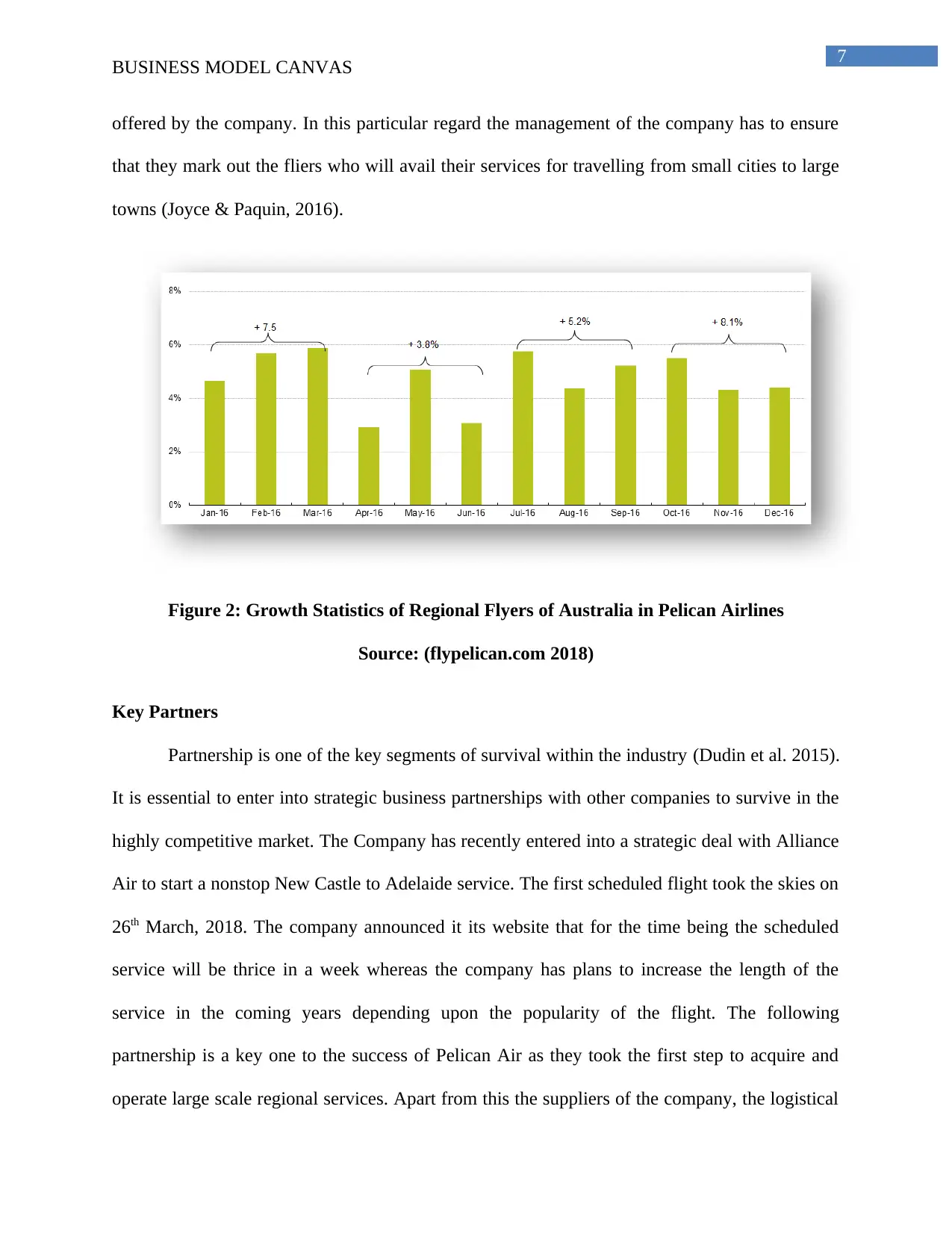
7
BUSINESS MODEL CANVAS
offered by the company. In this particular regard the management of the company has to ensure
that they mark out the fliers who will avail their services for travelling from small cities to large
towns (Joyce & Paquin, 2016).
Figure 2: Growth Statistics of Regional Flyers of Australia in Pelican Airlines
Source: (flypelican.com 2018)
Key Partners
Partnership is one of the key segments of survival within the industry (Dudin et al. 2015).
It is essential to enter into strategic business partnerships with other companies to survive in the
highly competitive market. The Company has recently entered into a strategic deal with Alliance
Air to start a nonstop New Castle to Adelaide service. The first scheduled flight took the skies on
26th March, 2018. The company announced it its website that for the time being the scheduled
service will be thrice in a week whereas the company has plans to increase the length of the
service in the coming years depending upon the popularity of the flight. The following
partnership is a key one to the success of Pelican Air as they took the first step to acquire and
operate large scale regional services. Apart from this the suppliers of the company, the logistical
BUSINESS MODEL CANVAS
offered by the company. In this particular regard the management of the company has to ensure
that they mark out the fliers who will avail their services for travelling from small cities to large
towns (Joyce & Paquin, 2016).
Figure 2: Growth Statistics of Regional Flyers of Australia in Pelican Airlines
Source: (flypelican.com 2018)
Key Partners
Partnership is one of the key segments of survival within the industry (Dudin et al. 2015).
It is essential to enter into strategic business partnerships with other companies to survive in the
highly competitive market. The Company has recently entered into a strategic deal with Alliance
Air to start a nonstop New Castle to Adelaide service. The first scheduled flight took the skies on
26th March, 2018. The company announced it its website that for the time being the scheduled
service will be thrice in a week whereas the company has plans to increase the length of the
service in the coming years depending upon the popularity of the flight. The following
partnership is a key one to the success of Pelican Air as they took the first step to acquire and
operate large scale regional services. Apart from this the suppliers of the company, the logistical
Paraphrase This Document
Need a fresh take? Get an instant paraphrase of this document with our AI Paraphraser
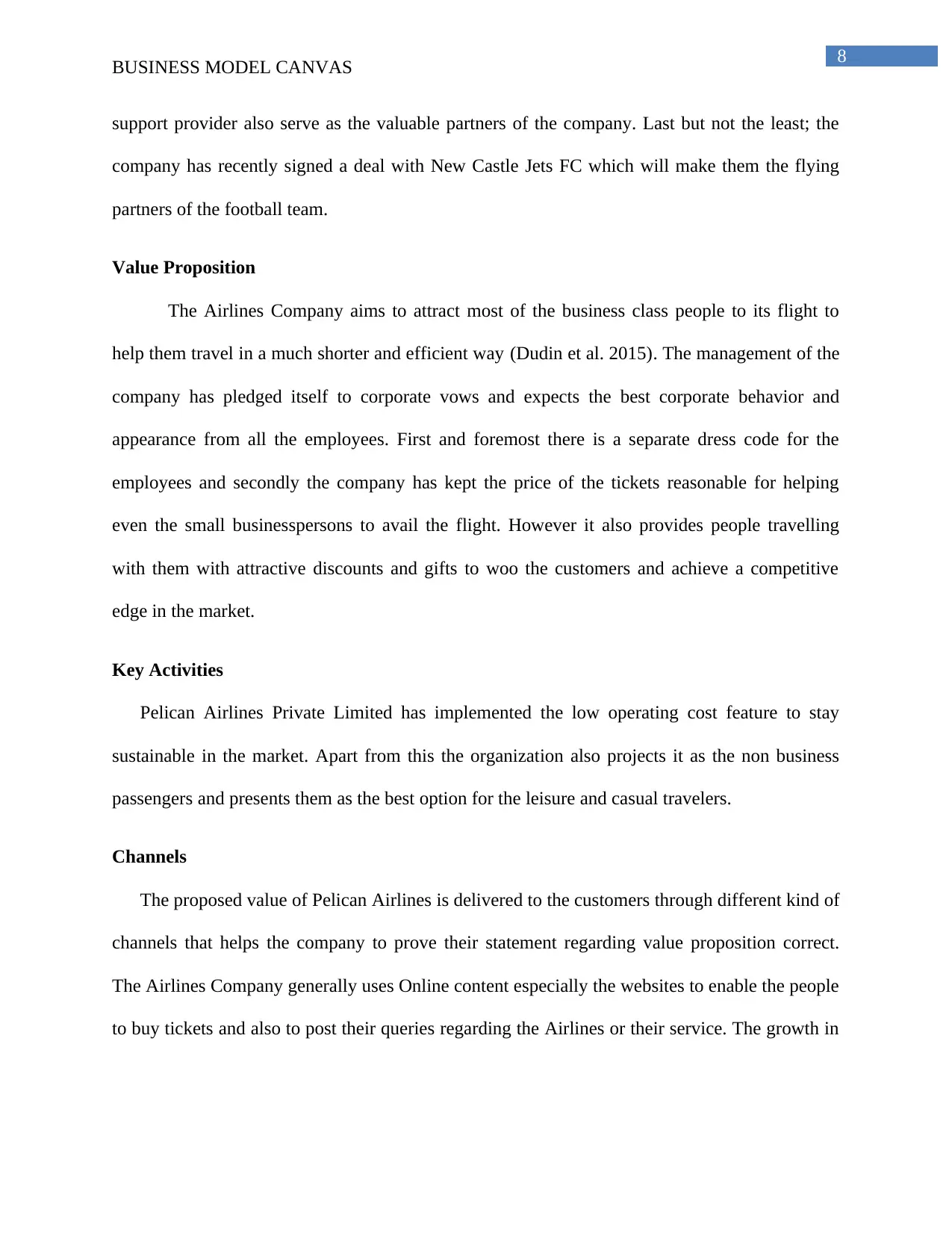
8
BUSINESS MODEL CANVAS
support provider also serve as the valuable partners of the company. Last but not the least; the
company has recently signed a deal with New Castle Jets FC which will make them the flying
partners of the football team.
Value Proposition
The Airlines Company aims to attract most of the business class people to its flight to
help them travel in a much shorter and efficient way (Dudin et al. 2015). The management of the
company has pledged itself to corporate vows and expects the best corporate behavior and
appearance from all the employees. First and foremost there is a separate dress code for the
employees and secondly the company has kept the price of the tickets reasonable for helping
even the small businesspersons to avail the flight. However it also provides people travelling
with them with attractive discounts and gifts to woo the customers and achieve a competitive
edge in the market.
Key Activities
Pelican Airlines Private Limited has implemented the low operating cost feature to stay
sustainable in the market. Apart from this the organization also projects it as the non business
passengers and presents them as the best option for the leisure and casual travelers.
Channels
The proposed value of Pelican Airlines is delivered to the customers through different kind of
channels that helps the company to prove their statement regarding value proposition correct.
The Airlines Company generally uses Online content especially the websites to enable the people
to buy tickets and also to post their queries regarding the Airlines or their service. The growth in
BUSINESS MODEL CANVAS
support provider also serve as the valuable partners of the company. Last but not the least; the
company has recently signed a deal with New Castle Jets FC which will make them the flying
partners of the football team.
Value Proposition
The Airlines Company aims to attract most of the business class people to its flight to
help them travel in a much shorter and efficient way (Dudin et al. 2015). The management of the
company has pledged itself to corporate vows and expects the best corporate behavior and
appearance from all the employees. First and foremost there is a separate dress code for the
employees and secondly the company has kept the price of the tickets reasonable for helping
even the small businesspersons to avail the flight. However it also provides people travelling
with them with attractive discounts and gifts to woo the customers and achieve a competitive
edge in the market.
Key Activities
Pelican Airlines Private Limited has implemented the low operating cost feature to stay
sustainable in the market. Apart from this the organization also projects it as the non business
passengers and presents them as the best option for the leisure and casual travelers.
Channels
The proposed value of Pelican Airlines is delivered to the customers through different kind of
channels that helps the company to prove their statement regarding value proposition correct.
The Airlines Company generally uses Online content especially the websites to enable the people
to buy tickets and also to post their queries regarding the Airlines or their service. The growth in
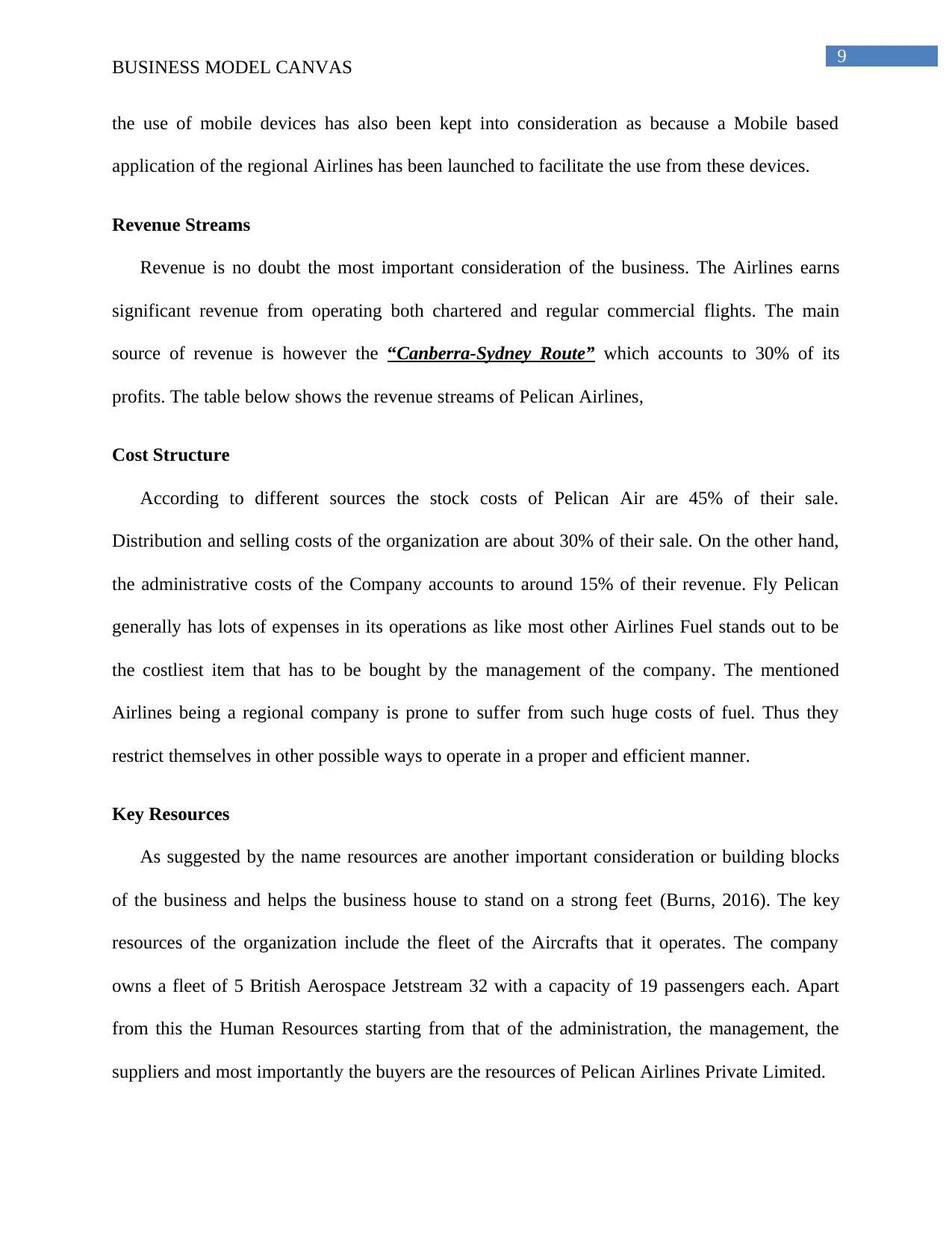
9
BUSINESS MODEL CANVAS
the use of mobile devices has also been kept into consideration as because a Mobile based
application of the regional Airlines has been launched to facilitate the use from these devices.
Revenue Streams
Revenue is no doubt the most important consideration of the business. The Airlines earns
significant revenue from operating both chartered and regular commercial flights. The main
source of revenue is however the “Canberra-Sydney Route” which accounts to 30% of its
profits. The table below shows the revenue streams of Pelican Airlines,
Cost Structure
According to different sources the stock costs of Pelican Air are 45% of their sale.
Distribution and selling costs of the organization are about 30% of their sale. On the other hand,
the administrative costs of the Company accounts to around 15% of their revenue. Fly Pelican
generally has lots of expenses in its operations as like most other Airlines Fuel stands out to be
the costliest item that has to be bought by the management of the company. The mentioned
Airlines being a regional company is prone to suffer from such huge costs of fuel. Thus they
restrict themselves in other possible ways to operate in a proper and efficient manner.
Key Resources
As suggested by the name resources are another important consideration or building blocks
of the business and helps the business house to stand on a strong feet (Burns, 2016). The key
resources of the organization include the fleet of the Aircrafts that it operates. The company
owns a fleet of 5 British Aerospace Jetstream 32 with a capacity of 19 passengers each. Apart
from this the Human Resources starting from that of the administration, the management, the
suppliers and most importantly the buyers are the resources of Pelican Airlines Private Limited.
BUSINESS MODEL CANVAS
the use of mobile devices has also been kept into consideration as because a Mobile based
application of the regional Airlines has been launched to facilitate the use from these devices.
Revenue Streams
Revenue is no doubt the most important consideration of the business. The Airlines earns
significant revenue from operating both chartered and regular commercial flights. The main
source of revenue is however the “Canberra-Sydney Route” which accounts to 30% of its
profits. The table below shows the revenue streams of Pelican Airlines,
Cost Structure
According to different sources the stock costs of Pelican Air are 45% of their sale.
Distribution and selling costs of the organization are about 30% of their sale. On the other hand,
the administrative costs of the Company accounts to around 15% of their revenue. Fly Pelican
generally has lots of expenses in its operations as like most other Airlines Fuel stands out to be
the costliest item that has to be bought by the management of the company. The mentioned
Airlines being a regional company is prone to suffer from such huge costs of fuel. Thus they
restrict themselves in other possible ways to operate in a proper and efficient manner.
Key Resources
As suggested by the name resources are another important consideration or building blocks
of the business and helps the business house to stand on a strong feet (Burns, 2016). The key
resources of the organization include the fleet of the Aircrafts that it operates. The company
owns a fleet of 5 British Aerospace Jetstream 32 with a capacity of 19 passengers each. Apart
from this the Human Resources starting from that of the administration, the management, the
suppliers and most importantly the buyers are the resources of Pelican Airlines Private Limited.
You're viewing a preview
Unlock full access by subscribing today!
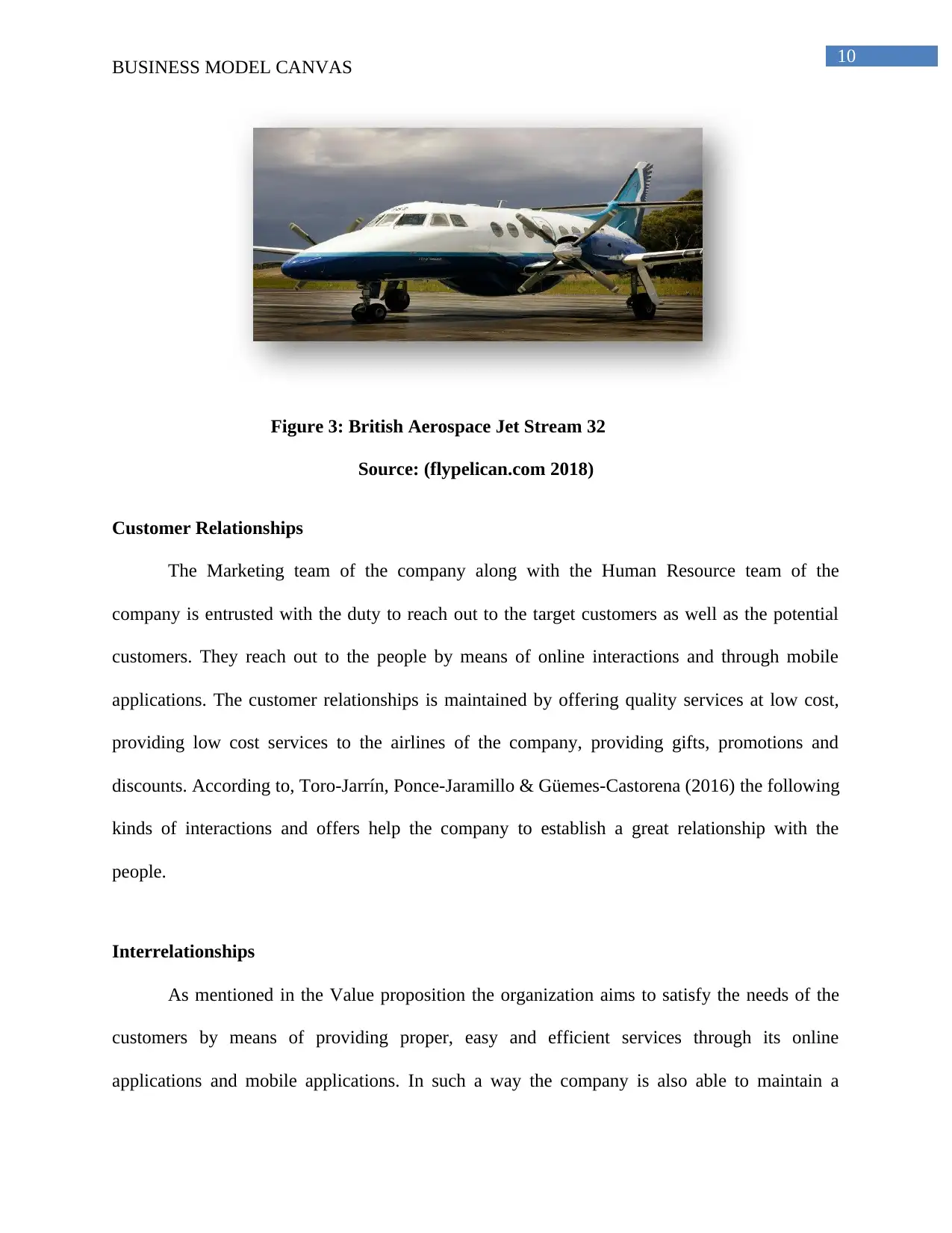
10
BUSINESS MODEL CANVAS
Figure 3: British Aerospace Jet Stream 32
Source: (flypelican.com 2018)
Customer Relationships
The Marketing team of the company along with the Human Resource team of the
company is entrusted with the duty to reach out to the target customers as well as the potential
customers. They reach out to the people by means of online interactions and through mobile
applications. The customer relationships is maintained by offering quality services at low cost,
providing low cost services to the airlines of the company, providing gifts, promotions and
discounts. According to, Toro-Jarrín, Ponce-Jaramillo & Güemes-Castorena (2016) the following
kinds of interactions and offers help the company to establish a great relationship with the
people.
Interrelationships
As mentioned in the Value proposition the organization aims to satisfy the needs of the
customers by means of providing proper, easy and efficient services through its online
applications and mobile applications. In such a way the company is also able to maintain a
BUSINESS MODEL CANVAS
Figure 3: British Aerospace Jet Stream 32
Source: (flypelican.com 2018)
Customer Relationships
The Marketing team of the company along with the Human Resource team of the
company is entrusted with the duty to reach out to the target customers as well as the potential
customers. They reach out to the people by means of online interactions and through mobile
applications. The customer relationships is maintained by offering quality services at low cost,
providing low cost services to the airlines of the company, providing gifts, promotions and
discounts. According to, Toro-Jarrín, Ponce-Jaramillo & Güemes-Castorena (2016) the following
kinds of interactions and offers help the company to establish a great relationship with the
people.
Interrelationships
As mentioned in the Value proposition the organization aims to satisfy the needs of the
customers by means of providing proper, easy and efficient services through its online
applications and mobile applications. In such a way the company is also able to maintain a
Paraphrase This Document
Need a fresh take? Get an instant paraphrase of this document with our AI Paraphraser
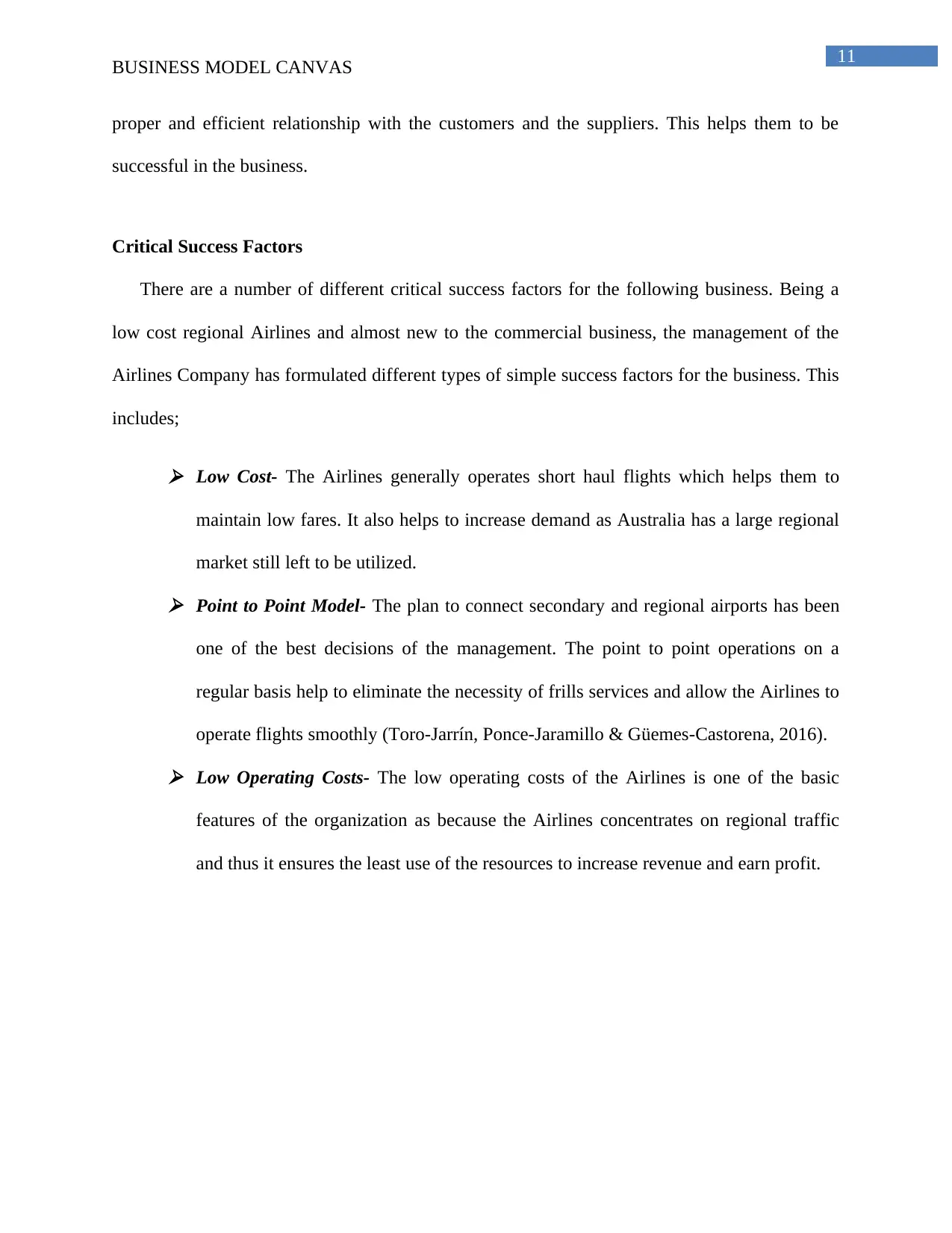
11
BUSINESS MODEL CANVAS
proper and efficient relationship with the customers and the suppliers. This helps them to be
successful in the business.
Critical Success Factors
There are a number of different critical success factors for the following business. Being a
low cost regional Airlines and almost new to the commercial business, the management of the
Airlines Company has formulated different types of simple success factors for the business. This
includes;
Low Cost- The Airlines generally operates short haul flights which helps them to
maintain low fares. It also helps to increase demand as Australia has a large regional
market still left to be utilized. Point to Point Model- The plan to connect secondary and regional airports has been
one of the best decisions of the management. The point to point operations on a
regular basis help to eliminate the necessity of frills services and allow the Airlines to
operate flights smoothly (Toro-Jarrín, Ponce-Jaramillo & Güemes-Castorena, 2016). Low Operating Costs- The low operating costs of the Airlines is one of the basic
features of the organization as because the Airlines concentrates on regional traffic
and thus it ensures the least use of the resources to increase revenue and earn profit.
BUSINESS MODEL CANVAS
proper and efficient relationship with the customers and the suppliers. This helps them to be
successful in the business.
Critical Success Factors
There are a number of different critical success factors for the following business. Being a
low cost regional Airlines and almost new to the commercial business, the management of the
Airlines Company has formulated different types of simple success factors for the business. This
includes;
Low Cost- The Airlines generally operates short haul flights which helps them to
maintain low fares. It also helps to increase demand as Australia has a large regional
market still left to be utilized. Point to Point Model- The plan to connect secondary and regional airports has been
one of the best decisions of the management. The point to point operations on a
regular basis help to eliminate the necessity of frills services and allow the Airlines to
operate flights smoothly (Toro-Jarrín, Ponce-Jaramillo & Güemes-Castorena, 2016). Low Operating Costs- The low operating costs of the Airlines is one of the basic
features of the organization as because the Airlines concentrates on regional traffic
and thus it ensures the least use of the resources to increase revenue and earn profit.
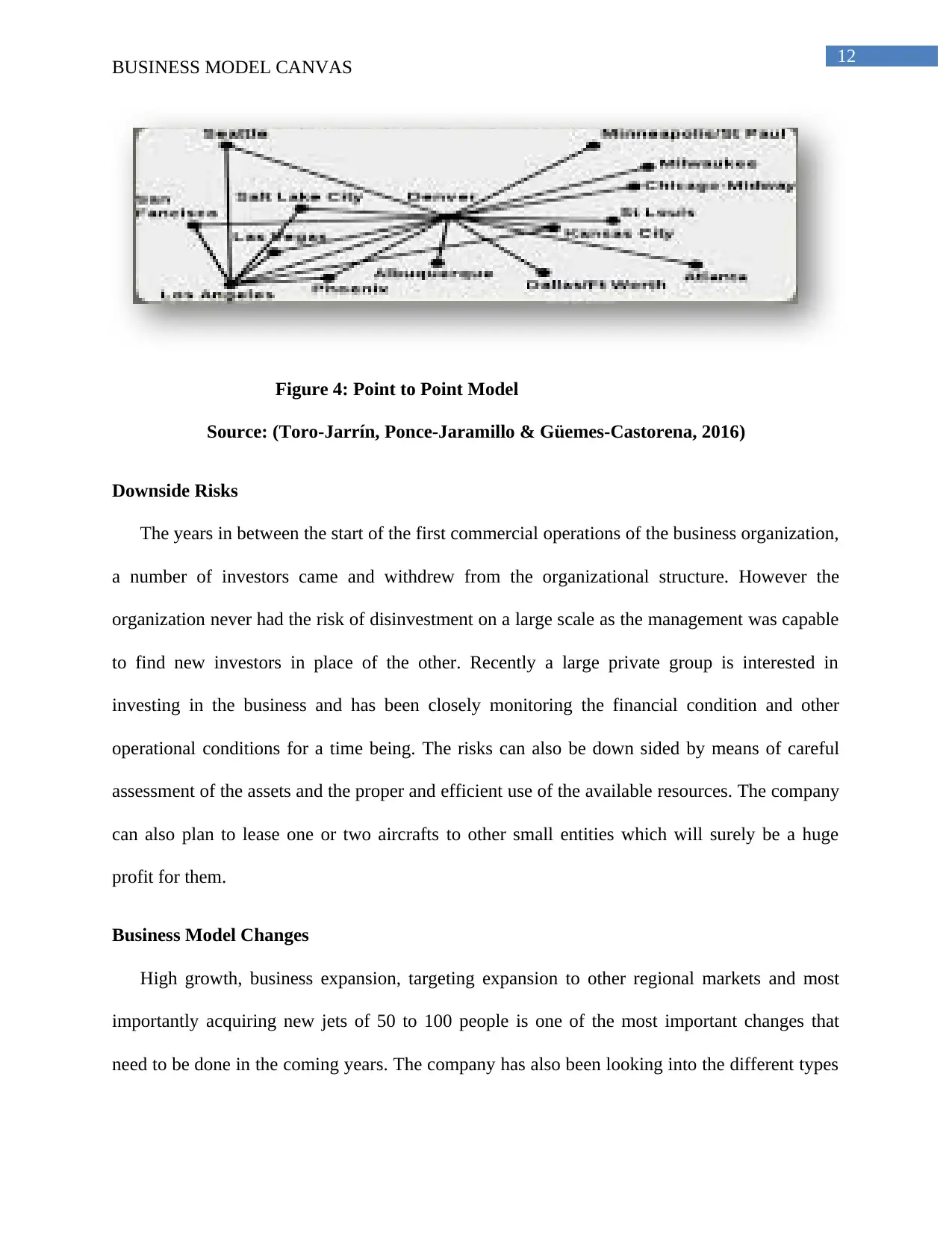
12
BUSINESS MODEL CANVAS
Figure 4: Point to Point Model
Source: (Toro-Jarrín, Ponce-Jaramillo & Güemes-Castorena, 2016)
Downside Risks
The years in between the start of the first commercial operations of the business organization,
a number of investors came and withdrew from the organizational structure. However the
organization never had the risk of disinvestment on a large scale as the management was capable
to find new investors in place of the other. Recently a large private group is interested in
investing in the business and has been closely monitoring the financial condition and other
operational conditions for a time being. The risks can also be down sided by means of careful
assessment of the assets and the proper and efficient use of the available resources. The company
can also plan to lease one or two aircrafts to other small entities which will surely be a huge
profit for them.
Business Model Changes
High growth, business expansion, targeting expansion to other regional markets and most
importantly acquiring new jets of 50 to 100 people is one of the most important changes that
need to be done in the coming years. The company has also been looking into the different types
BUSINESS MODEL CANVAS
Figure 4: Point to Point Model
Source: (Toro-Jarrín, Ponce-Jaramillo & Güemes-Castorena, 2016)
Downside Risks
The years in between the start of the first commercial operations of the business organization,
a number of investors came and withdrew from the organizational structure. However the
organization never had the risk of disinvestment on a large scale as the management was capable
to find new investors in place of the other. Recently a large private group is interested in
investing in the business and has been closely monitoring the financial condition and other
operational conditions for a time being. The risks can also be down sided by means of careful
assessment of the assets and the proper and efficient use of the available resources. The company
can also plan to lease one or two aircrafts to other small entities which will surely be a huge
profit for them.
Business Model Changes
High growth, business expansion, targeting expansion to other regional markets and most
importantly acquiring new jets of 50 to 100 people is one of the most important changes that
need to be done in the coming years. The company has also been looking into the different types
You're viewing a preview
Unlock full access by subscribing today!
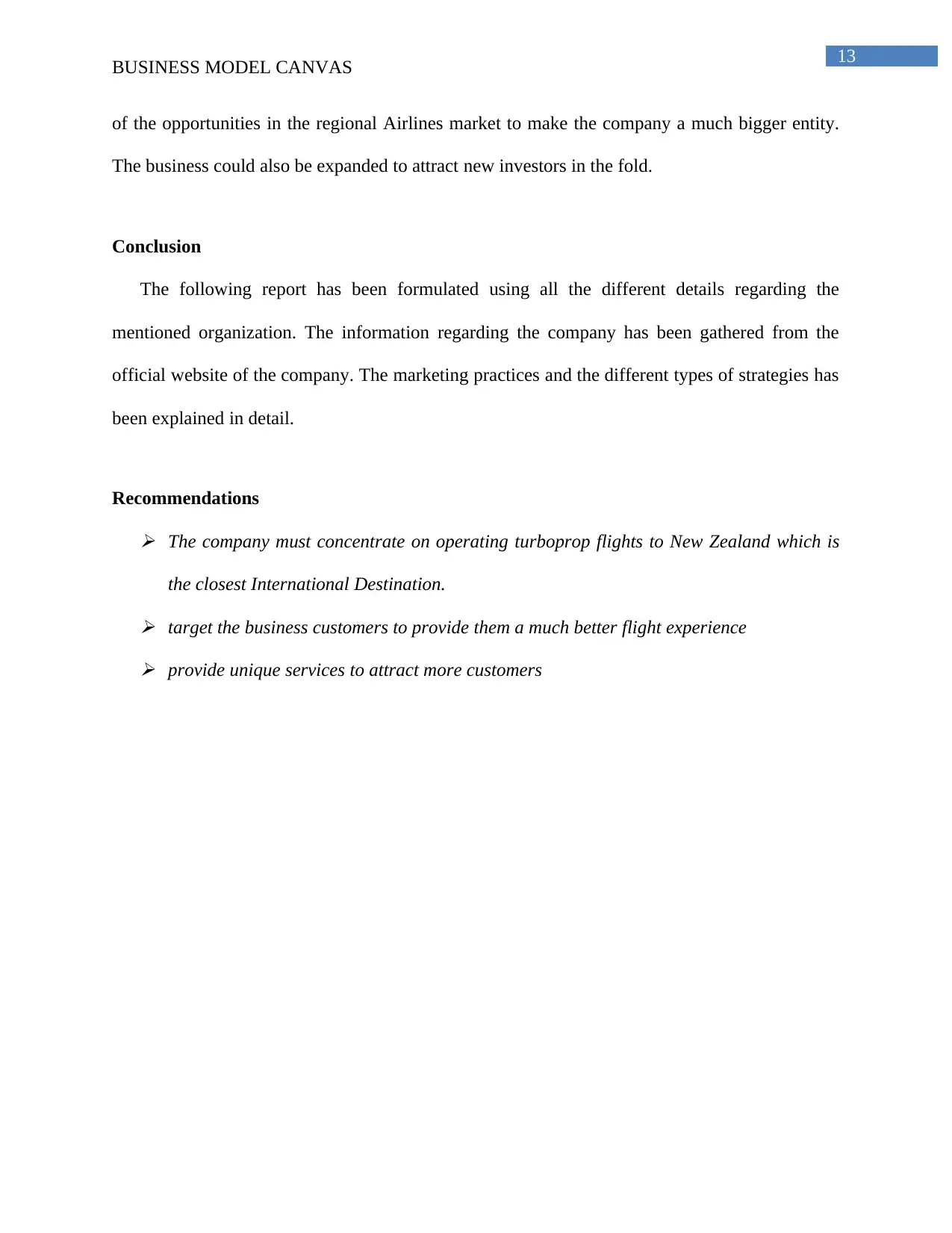
13
BUSINESS MODEL CANVAS
of the opportunities in the regional Airlines market to make the company a much bigger entity.
The business could also be expanded to attract new investors in the fold.
Conclusion
The following report has been formulated using all the different details regarding the
mentioned organization. The information regarding the company has been gathered from the
official website of the company. The marketing practices and the different types of strategies has
been explained in detail.
Recommendations The company must concentrate on operating turboprop flights to New Zealand which is
the closest International Destination. target the business customers to provide them a much better flight experience provide unique services to attract more customers
BUSINESS MODEL CANVAS
of the opportunities in the regional Airlines market to make the company a much bigger entity.
The business could also be expanded to attract new investors in the fold.
Conclusion
The following report has been formulated using all the different details regarding the
mentioned organization. The information regarding the company has been gathered from the
official website of the company. The marketing practices and the different types of strategies has
been explained in detail.
Recommendations The company must concentrate on operating turboprop flights to New Zealand which is
the closest International Destination. target the business customers to provide them a much better flight experience provide unique services to attract more customers
Paraphrase This Document
Need a fresh take? Get an instant paraphrase of this document with our AI Paraphraser
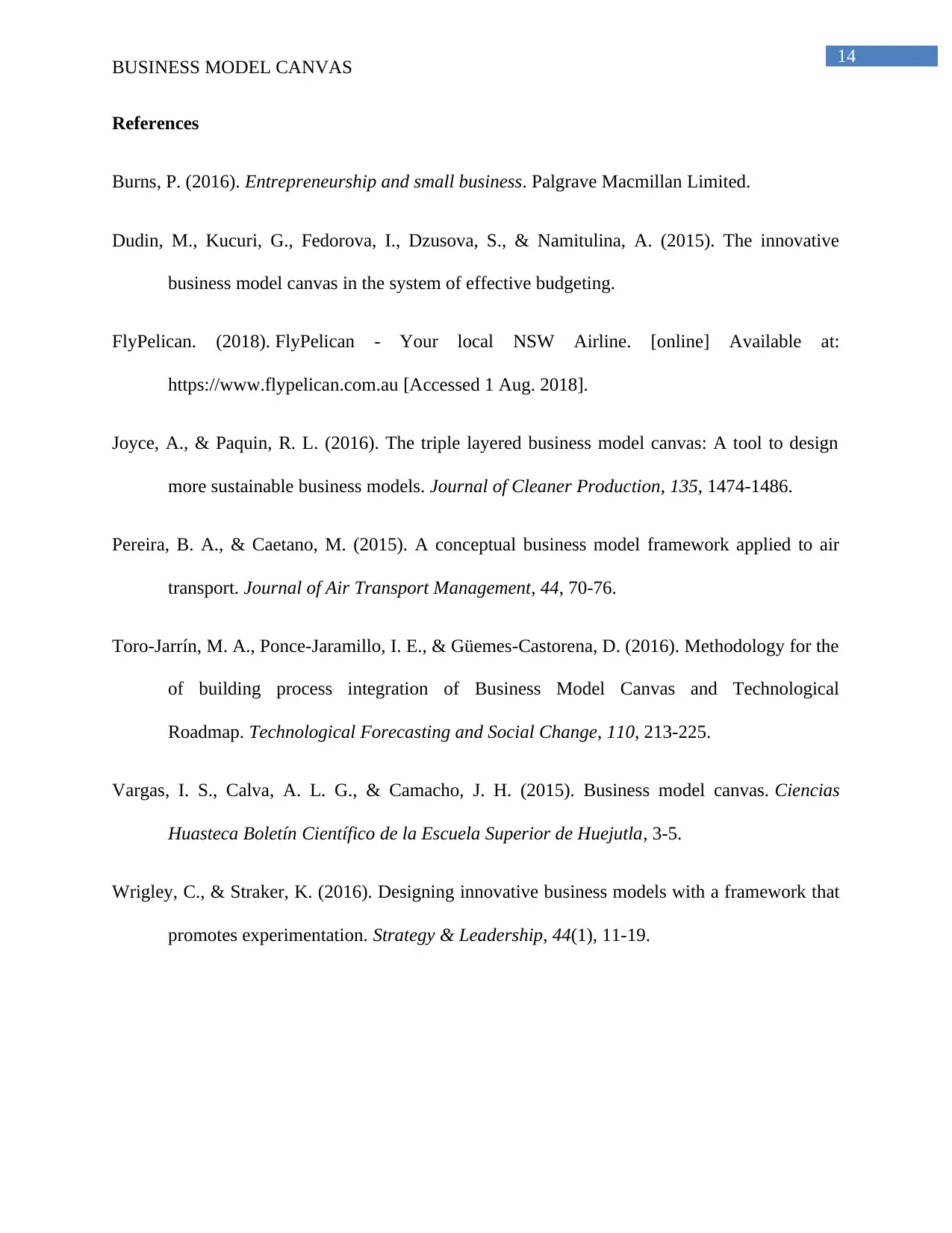
14
BUSINESS MODEL CANVAS
References
Burns, P. (2016). Entrepreneurship and small business. Palgrave Macmillan Limited.
Dudin, M., Kucuri, G., Fedorova, I., Dzusova, S., & Namitulina, A. (2015). The innovative
business model canvas in the system of effective budgeting.
FlyPelican. (2018). FlyPelican - Your local NSW Airline. [online] Available at:
https://www.flypelican.com.au [Accessed 1 Aug. 2018].
Joyce, A., & Paquin, R. L. (2016). The triple layered business model canvas: A tool to design
more sustainable business models. Journal of Cleaner Production, 135, 1474-1486.
Pereira, B. A., & Caetano, M. (2015). A conceptual business model framework applied to air
transport. Journal of Air Transport Management, 44, 70-76.
Toro-Jarrín, M. A., Ponce-Jaramillo, I. E., & Güemes-Castorena, D. (2016). Methodology for the
of building process integration of Business Model Canvas and Technological
Roadmap. Technological Forecasting and Social Change, 110, 213-225.
Vargas, I. S., Calva, A. L. G., & Camacho, J. H. (2015). Business model canvas. Ciencias
Huasteca Boletín Científico de la Escuela Superior de Huejutla, 3-5.
Wrigley, C., & Straker, K. (2016). Designing innovative business models with a framework that
promotes experimentation. Strategy & Leadership, 44(1), 11-19.
BUSINESS MODEL CANVAS
References
Burns, P. (2016). Entrepreneurship and small business. Palgrave Macmillan Limited.
Dudin, M., Kucuri, G., Fedorova, I., Dzusova, S., & Namitulina, A. (2015). The innovative
business model canvas in the system of effective budgeting.
FlyPelican. (2018). FlyPelican - Your local NSW Airline. [online] Available at:
https://www.flypelican.com.au [Accessed 1 Aug. 2018].
Joyce, A., & Paquin, R. L. (2016). The triple layered business model canvas: A tool to design
more sustainable business models. Journal of Cleaner Production, 135, 1474-1486.
Pereira, B. A., & Caetano, M. (2015). A conceptual business model framework applied to air
transport. Journal of Air Transport Management, 44, 70-76.
Toro-Jarrín, M. A., Ponce-Jaramillo, I. E., & Güemes-Castorena, D. (2016). Methodology for the
of building process integration of Business Model Canvas and Technological
Roadmap. Technological Forecasting and Social Change, 110, 213-225.
Vargas, I. S., Calva, A. L. G., & Camacho, J. H. (2015). Business model canvas. Ciencias
Huasteca Boletín Científico de la Escuela Superior de Huejutla, 3-5.
Wrigley, C., & Straker, K. (2016). Designing innovative business models with a framework that
promotes experimentation. Strategy & Leadership, 44(1), 11-19.
1 out of 14
Related Documents
Your All-in-One AI-Powered Toolkit for Academic Success.
+13062052269
info@desklib.com
Available 24*7 on WhatsApp / Email
![[object Object]](/_next/static/media/star-bottom.7253800d.svg)
Unlock your academic potential
© 2024 | Zucol Services PVT LTD | All rights reserved.





